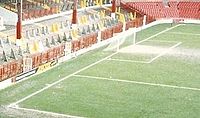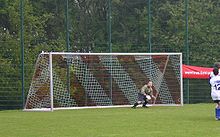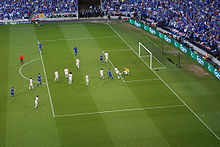- Association football pitch
-
 Standard pitch measurements. Not all pitches are the same size, though 105m (115yd) by 68m (74yd), or 7140 m², is the preferred size for many professional teams' stadiums (for example: Camp Nou, San Siro, Old Trafford, Allianz Arena, Elland Road) with other pitches' size a slight variation (Stamford Bridge, Santiago Bernabeu, La Bombonera)
Standard pitch measurements. Not all pitches are the same size, though 105m (115yd) by 68m (74yd), or 7140 m², is the preferred size for many professional teams' stadiums (for example: Camp Nou, San Siro, Old Trafford, Allianz Arena, Elland Road) with other pitches' size a slight variation (Stamford Bridge, Santiago Bernabeu, La Bombonera)
An association football pitch (also known as a football pitch, football field[1] or soccer field) is the playing surface for the game of association football made of turf. Its dimensions and markings are defined by Law 1 of the Laws of the Game, "The Field of Play".[2]
All line markings on the pitch form part of the area which they define. For example, a ball on or above the touchline is still on the field of play; a ball on the line of the goal area is in the goal area; and a foul committed over the 16.5-metre (18-yard) line has occurred in the penalty area. Therefore a ball must completely cross the touchline to be out of play, and a ball must wholly cross the goal line (between the goal posts) before a goal is scored; if any part of the ball is still on or above the line, the ball is still in play.
The field descriptions that apply to adult matches are described below. Note that due to the original formulation of the Laws in England and the early supremacy of the four British football associations within IFAB, the standard dimensions of a football pitch were originally expressed in imperial units. The Laws now express dimensions with approximate metric equivalents (followed by traditional units in brackets), but use of the imperial units remains common in some countries, especially in the United Kingdom.
Contents
Pitch boundary
The pitch is rectangular in shape. The longer sides are called touchlines. The other opposing sides are called the goal lines. The two goal lines must be between 45 and 90 m (50 and 100 yd) and be the same length.[3] The two touch lines must also be of the same length, and be between 90 and 120 m (100 and 130 yd) in length.[3] However, in international matches, the goal lines must be between 64 and 75 m (70 and 80 yd) long and the touchlines must be between 100 and 110 m (110 and 120 yd).[3]
Since 2007,[citation needed] in order to standardize the size of the football pitch for A international matches, the IFAB has decided to set a fixed size of 105 m long and 68 m wide, 7140 m²,[4] although as at 1 July 2011 this amendment is not reflected in the Laws of the Game. In 2008, the average English Premiership pitch measured 114 by 74 yards (104 × 68 m), with an average area of 8,414 square yards (7,035 m2).[citation needed]
Although the term goal line is often taken to mean only that part of the line between the goalposts, in fact it refers to the complete line at either end of the pitch, from one corner flag to the other. In contrast, the term byline (or by-line) is often used to refer to that portion of the goal line outside the goalposts. This term is commonly used in football commentaries and match descriptions, such as this example from a BBC match report; "Udeze gets to the left byline and his looping cross is cleared..."[5]
Goals
Goals are placed at the centre of each goal-line.[6] These consist of two upright posts placed equidistant from the corner flagposts, joined at the top by a horizontal crossbar. The inner edges of the posts must be 7.32 m (8 yds) apart, and the lower edge of the crossbar must be 2.44 m (8 feet) above the ground. Nets are usually placed behind the goal, though are not required by the Laws.
Goalposts and crossbars must be white, and made of wood, metal or other approved material. Rules regarding the shape of goalposts and crossbars are somewhat more lenient, but they must conform to a shape that does not pose a threat to players.
A goal is scored when the ball completely crosses the goal line between the goal-posts, even if a defending player last touched the ball before it crossed the goal line (see own goal). A goal may, however, be ruled illegal (and void by the referee) if the player who scored or a member of his team commits an offence under any of the laws between the time the ball was previously out of play and the goal being scored. It is also deemed void if a player on the opposing team commits an offence before the ball has passed the line, as in the case of fouls being committed, a penalty awarded but the ball continued on a path that caused it to cross the goal line.
History of football goals and nets
Football goals are first described in England in the late 16th and early 17th centuries. In 1584 and 1602 respectively, John Norden and Richard Carew referred to "goals" in Cornish hurling. Carew described how goals were made: "they pitch two bushes in the ground, some eight or ten foote asunder; and directly against them, ten or twelue [twelve] score off, other twayne in like distance, which they terme their Goales".[7] The first reference to scoring a goal is in John Day's play The Blind Beggar of Bethnal Green (performed circa 1600; published 1659): (an extremely violent variety of football, which was popular in East Anglia). Similarly in a poem in 1613, Michael Drayton refers to "when the Ball to throw, And drive it to the Gole, in squadrons forth they goe". Solid crossbars were first introduced by the Sheffield Rules. Football nets were invented by Liverpool engineer John Brodie in 1891.[8]
Penalty and goal areas
Two rectangular boxes are marked out on the pitch in front of each goal.
The goal area (colloquially the "six-yard box"), consists of the area formed by the goal-line, two lines starting on the goal-line 5.5 m (6 yds) from the goalposts and extending 5.5 m (6 yds) into the pitch from the goal-line, and a line joining these. Goal kicks and any free kick by the defending team may be taken from anywhere in this area. Indirect free kicks awarded to the attacking team within the goal area must be taken from the point on the line parallel to the goal line nearest where an incident occurred; they can not be taken further within the goal-area. Similarly drop-balls that would otherwise occur in the goal area are taken on this line.
The penalty area (colloquially "The 18 yard box" or just "The box") is similarly formed by the goal-line and lines extending from it, however its lines commence 16.5 m (18 yd) from the goalposts and extend 16.5 m (18 yds) into the field. This area has a number of functions, the most prominent being to denote where the goalkeeper may handle the ball and where a foul by a defender, usually punished by a direct free kick, becomes punishable by a penalty kick.
The penalty mark (or "penalty spot") is 11 m (12 yds) in front of the very center of the goal; this is the point from where penalty kicks are taken. The penalty arc (colloquially "the D") is marked from the outside edge of the penalty area, 9.15 m (10 yds) from the penalty mark; this, along with the penalty area, marks an exclusion zone for all players other than the attacking kicker and defending goalkeeper during a penalty kick.
Other markings
The centre circle is marked at 9.15 m (10 yd) from the centre spot. Similar to the penalty arc, this indicates the minimum distance that opposing players must keep at kick-off; the ball itself is placed on the centre spot. During penalty shootouts all players other than the two goalkeepers and the current kicker are required to remain within this circle.
The half-way line divides the pitch in two. The half which a team defends is commonly referred to as being theirs. Players must be within their own half at a kick-off and may not be penalised as being offside in their own half.
The arcs in the corners denote the area (within 1 yard of the corner) in which the ball has to be placed for corner kicks; other players have to be 10 yards away during a corner, and there are lines off-pitch 10 yards away from the corner on the goal- and the touch-lines to help gauge these distances.
Turf
Grass is the normal surface of play, although artificial turf may be used as well, especially in locations where maintenance of grass may be difficult due to inclement weather. This may include areas where it is very wet, causing the grass to deteriorate rapidly, where it is very dry, causing the grass to die, and where the turf is under heavy use. The latest artificial surfaces use rubber crumbs, as opposed to the previous system of sand infill.
Associated areas
Aside from the field of play, the Laws and by-laws can be used to regulate related areas off the field. The most prominent of these is the technical area, which defines the bench areas and nearby areas to which coaching and managing staff are generally restricted. At top level football grounds, the technical area is usually marked out with a dashed line. Note that the referee's authority extends not only to the field of play, but also its immediate surroundings, including the technical area.
References
- ^ For example, George Cumming, Manager Project Future Referees (2009-12-09). "Evolution of football field markings". Asian Football Confederation. http://www.the-afc.com/en/football-development/referees/26293-evolution-of-football-field-markings.
- ^ TalkFootball. "TalkFootball: Premiership football stadiums". TalkFootball. http://www.talkfootball.co.uk/guides/premiership_football_stadiums.html. Retrieved 2011-01-06.
- ^ a b c "Laws of the Game 2011/2012". FIFA. p. 7. http://www.fifa.com/mm/document/affederation/generic/81/42/36/lawsofthegame_2011_12e.pdf. Retrieved 12 August 2011.
- ^ "Goal-line technology put on ice". IFAB media release. FIFA. 8 March 2008. http://www.fifa.com/aboutfifa/organisation/ifab/media/news/newsid=707751/. Retrieved 12 August 2011.
- ^ Match report BBC
- ^ "Laws of the Game 2011/2012". FIFA. p. 9. http://www.fifa.com/mm/document/affederation/generic/81/42/36/lawsofthegame_2011_12e.pdf. Retrieved 12 August 2011.
- ^ Richard Carew. "EBook of The Survey of Cornwall". Project Gutenberg. http://www.gutenberg.org/dirs/etext06/srvcr10.txt. Retrieved 2007-10-03.
- ^ Herbert, Ian (2000-07-07). "Blue plaque for man who invented football goal net". The Independent (London). http://www.independent.co.uk/news/uk/this-britain/blue-plaque-for-man-who-invented-football-goal-net-707003.html. Retrieved 2010-04-25.
Laws of the Game - Rules of Association football Terms Law 1: The Field of Play · Law 2: The Ball · Law 3: The Number of Players · Law 4: The Players' Equipment · Law 5: The Referee · Law 6: The Assistant Referees · Law 7: The Duration of the Match · Law 8: The Start and Restart of Play · Law 9: The Ball In and Out of Play · Law 10: The Method of Scoring · Law 11: Offside · Law 12: Fouls and Misconduct · Law 13: Free kicks (direct and indirect) · Law 14: The Penalty Kick · Law 15: The Throw-In · Law 16: The Goal Kick · Law 17: Corner kickInternational Football
Association Board (IFAB)Categories:- Laws of association football
- Sports rules and regulations
Wikimedia Foundation. 2010.



